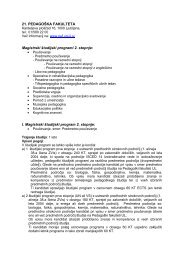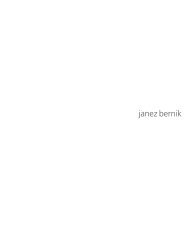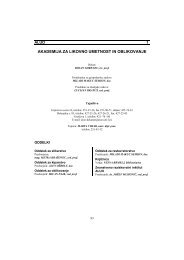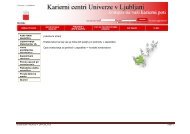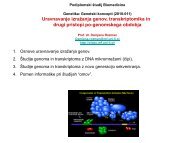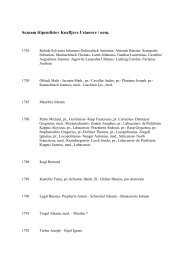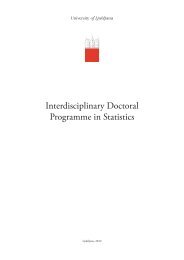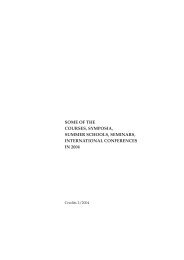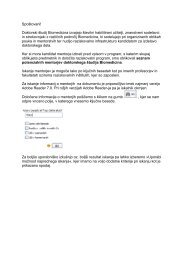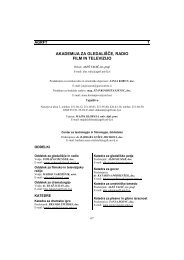Medicinska fakulteta Univerze v Ljubljani 1919–1945 - Univerza v ...
Medicinska fakulteta Univerze v Ljubljani 1919–1945 - Univerza v ...
Medicinska fakulteta Univerze v Ljubljani 1919–1945 - Univerza v ...
You also want an ePaper? Increase the reach of your titles
YUMPU automatically turns print PDFs into web optimized ePapers that Google loves.
professional evaluations, the Faculty Council proposed filling<br />
these vacancies with Dr France Hribar, currently prosector at<br />
the Maribor Hospital, as full professor of pathology, Dr Karlo<br />
Lušicky, currently assistant at the Zagreb Internal Clinic, as full<br />
professor of internal medicine and Dr Božidar Lavrič, the chief<br />
physician of the Second Surgical Unit of the General Hospital in<br />
Ljubljana, as full professor of surgery� On the University Council’s<br />
proposal all the candidates were appointed on 27 June 1940 and<br />
promptly started work at the Ljubljana University� Third-year<br />
lectures started in the autumn of 1940� Professor Hribar, who was<br />
elected dean for the 1940/41 academic year, led the campaign to<br />
further expand the faculty as soon as possible� In 1941, a draft<br />
for the reform of the whole medicine course was produced at a<br />
meeting of the Faculty Council� The plan was to open the seventh<br />
and eighth semesters in the 1942/43 academic year, but this was<br />
prevented by the Second World War�<br />
The Faculty of Medicine during the Second<br />
World War<br />
After Slovenia was occupied, the university was temporarily<br />
closed but when reopened, its vitality started to wane� Even<br />
before the war, the democratic fortress had become the hub<br />
of resistance� The Italian authorities exerted pressure on the<br />
rector, university teachers and students, which was followed by<br />
mass raids, deportations and the first victims� For the 1941/42<br />
academic year, the office of dean of the Faculty of Medicine was<br />
entrusted to Prof� Božidar Lavrič and, after his internment, the<br />
dean’s duties were taken over by Prof� Karel Lušicky on 3 March<br />
1942� Besides dean Lavrič, the following professors were arrested:<br />
Ladislav Klinc, Alija Košir, Milan Cunder, as well as the assistants:<br />
Martin Benedik, Milan Žumer and Franc Derganc� The rector<br />
Milko Kos repeatedly intervened with the authorities for their<br />
release without success� In 1942, the first faculty workers joined<br />
the partisans and after Italy capitulated, their numbers increased�<br />
Having little staff to start with, the faculty was left with only a<br />
few people� From the 19 teachers and associates it had at the<br />
beginning of 1941, eight were absent�<br />
In the first half of 1943, the former Banovina Institute for the<br />
Research and Treatment of Neoplasms was integrated into the<br />
Faculty of Medicine� The gynaecologist and oncologist Dr Leo<br />
Šavnik was appointed as its director�<br />
After Italy’s capitulation, the president of the Regional Administration,<br />
General Rupnik, promised his full support to the<br />
university and he was duly addressed by the rector in 1943<br />
at the request of dean Lušicky with a proposal to extend the<br />
Medical Faculty to the full term of 10 semesters� The dean also<br />
explained that new teaching manpower would be acquired with<br />
126<br />
chief physicians from the hospital who were already considering<br />
temporary engagement as part-time lecturers� The faculty was<br />
given approval to open only the seventh semester� The Faculty<br />
Council at once asked for approval to open the eighth semester as<br />
well, but was refused� On 11 November 1943, all lectures at the<br />
Ljubljana University were stopped until further notice by decision<br />
of the head of the Regional Administration, Leon Rupnik�<br />
The Students of the Faculty of Medicine in<br />
Ljubljana<br />
In the period between the World Wars, due to its unfavourable<br />
spatial situation and incompleteness, the Faculty of Medicine<br />
was the smallest of all Ljubljana University faculties in terms of<br />
the number of students� From the winter semester of 1919 to<br />
the winter semester of 1943, it was attended by around 1860<br />
students� The conditions in which it operated forced it to limit<br />
the number of first-year places in the very first academic year and<br />
many other times later� In addition to Slovenians, the Ljubljana<br />
Medical Faculty was attended by students from other parts of<br />
the country, with many students enrolling from abroad� In the<br />
twenties, Russians dominated the enrolled foreigners; there were<br />
28 in total� In the early thirties, the Ljubljana Medical Faculty<br />
was sought by students of Jewish origin from Poland and, in<br />
the second half of the thirties, the enrolled students included<br />
55 Bulgarians� Over the entire period, the faculty also admitted<br />
16 students from Czechoslovakia and individuals from other<br />
countries� In view of the increased number of enrolled students<br />
from Poland - 59 in the 1933/34 academic year - the dean’s office<br />
of the Faculty of Medicine reported the situation to the Medical<br />
Chamber in 1933, stressing the need to protect the interests of<br />
Slovenian doctors� In agreement with the rector and in line with<br />
the position of the minister of social policy and national health it<br />
was decided that foreigners would be prevented from practising<br />
in Yugoslavia after the war� At a Faculty Council meeting it was<br />
also decided that foreign students could only enrol in the first<br />
semester of medicine provided that the number of total students<br />
enrolled in all four semesters was lower than 180� Despite<br />
the faculty’s difficult situation and restricted enrolment, the<br />
percentage of medical students rose over the years� According to<br />
the data collected by Vasilij Melik, Ljubljana University always<br />
comprised more than 10% medical students, after 1932/32 above<br />
20% and just before the Second World War around 30%� The<br />
proportion of female students rose as well and in the wartime<br />
exceeded half of the total number of students enrolled� As a<br />
whole, the first generation of enrolled students was the youngest<br />
in the population attending the Ljubljana University, consisting<br />
mostly of the post-war generation of secondary school graduates�<br />
Although the Ljubljana Faculty of Medicine operated in difficult<br />
conditions, all the prescribed courses were taught and all the



